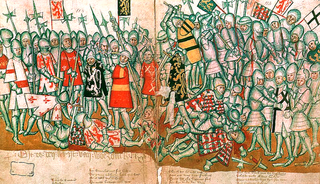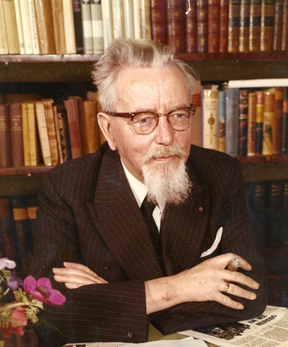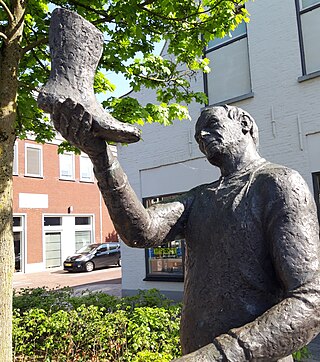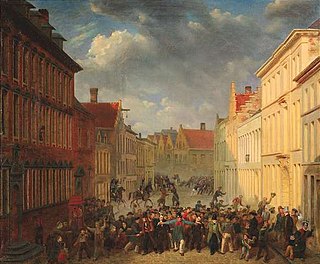
The Mauritshuis is an art museum in The Hague, Netherlands. The museum houses the Royal Cabinet of Paintings which consists of 854 objects, mostly Dutch Golden Age paintings. The collection contains works by Johannes Vermeer, Rembrandt van Rijn, Jan Steen, Paulus Potter, Frans Hals, Jacob van Ruisdael, Hans Holbein the Younger, and others. Originally, the 17th-century building was the residence of count John Maurice of Nassau. It is now the property of the government of the Netherlands and is listed in the top 100 Dutch heritage sites.

Diest is a city and municipality located in the Belgian province of Flemish Brabant. Situated in the northeast of the Hageland region, Diest neighbours the provinces of Antwerp to its North, and Limburg to the East and is situated around 60 km from Brussels. The municipality comprises the city of Diest proper and the towns of Deurne, Kaggevinne, Molenstede, Schaffen and Webbekom. As of January 1, 2006, Diest had a total population of 22,845. The total area is 58.20 km² which gives a population density of 393 inhabitants per km².

The naval Battle of Texel or Battle of Kijkduin took place off the western coast of the island of Texel on 21 August 1673 between the Dutch and the combined English and French fleets. It was the last major battle of the Third Anglo-Dutch War, which was itself part of the Franco-Dutch War (1672–1678), during which Louis XIV of France invaded the Republic and sought to establish control over the Spanish Netherlands. English involvement came about because of the Treaty of Dover, secretly concluded by Charles II of England, and which was highly unpopular with the English Parliament.

The Battle of Worringen was fought on 5 June 1288 near the town of Worringen, which is now the northernmost borough of Cologne. It was the decisive battle of the War of the Limburg Succession, fought for the possession of the Duchy of Limburg between on one side the Archbishop Siegfried II of Cologne and Count Henry VI of Luxembourg, and on the other side, Duke John I of Brabant.

Andreas Ernestus Josephus Claes was a Belgian author. He is best known for his regional novels, including De Witte ("Whitey"), which was the source material for the first Flemish movie: De Witte (1920). In 1980 it was remade as De Witte van Sichem by Robbe De Hert.

Robin François De Hert was a Belgian film director.

The Duchy of Brabant, a state of the Holy Roman Empire, was established in 1183. It developed from the Landgraviate of Brabant of 1085–1183, and formed the heart of the historic Low Countries. The Duchy comprised part of the Burgundian Netherlands from 1430 and of the Habsburg Netherlands from 1482, until it was partitioned after the Dutch revolt of 1566–1648.

Cinema of Belgium refers to the film industry based in Belgium. Belgium is essentially a bi-lingual country divided into the Flemish (Dutch-speaking) north and the French-speaking south. There is also a small community of German speakers in the border region with Germany. Belgium is further a federal country made up of three regions and three language communities . Due to these linguistic and political divisions it is difficult to speak of a national, unified Cinema of Belgium. It would be more appropriate to talk about Flemish or Dutch-language cinema of Belgium and Walloon or French-language cinema of Belgium.

Kaatsheuvel is a town in the province of North Brabant, Netherlands situated along highways N261 and N628. With a population of roughly 16,600, it is the largest town in and the capital of the municipality of Loon op Zand, which also consists of the villages of De Moer and Loon op Zand.

Orangism was a political tradition in Belgium that supported its reintegration into the short-lived United Kingdom of the Netherlands (1815–1830) under the rule of the Dutch House of Orange. It existed principally in the 1830s and 1840s.
De Witt is the name of an old Dutch patrician and regenten family. Originally from Dordrecht, the genealogy of the family begins with Jan de Witte, a patrician who lived around 1295. The family have played an important role during the Dutch Golden Age. They were at the centre of Dordrecht and Holland oligarchy from the end of the 16th century until 1672, and belonged to the Dutch States Party.

The Basilica of Our Lady of Scherpenheuvel is a Roman Catholic parish church and minor basilica in Scherpenheuvel-Zichem, Belgium. The church was consecrated in 1627 and raised to the status of a minor basilica in 1922. It is reputedly the most frequently visited shrine of pilgrimage in Belgium. While the cult on the Scherpenheuvel is older, its present architectural layout and its enduring importance are due to the patronage of the Archdukes Albert and Isabella and the Counter-Reformation.

Lady Mary of Looz-Heinsberg, Dutch: Maria van Loon-Heinsberg, was a noble lady from the House of Looz and through marriage Countess of Nassau-Siegen.

Hereditary Count John Ernest of Nassau-Siegen, German: Johann Ernst Erbgraf von Nassau-Siegen, official titles: Graf zu Nassau, Katzenelnbogen, Vianden und Diez, Herr zu Beilstein, was since 1607 Hereditary Count of Nassau-Siegen, a part of the County of Nassau. He descended from the House of Nassau-Siegen, a cadet branch of the Ottonian Line of the House of Nassau. He first served as an officer in the Dutch States Army and later as general in the Republic of Venice during the Uskok War.

Nicolaes Hasselaer, was a Dutch Golden Age brewer and major of the Amsterdam schutterij, who is best known today for his portrait by Frans Hals.

De Witte is a Belgian film of 1934 in black and white, directed by Jan Vanderheyden. It is an adaptation of the homonymous book by Ernest Claes.

Whitey, original title: De Witte van Sichem, is a Belgian movie by Robbe De Hert released in 1980. The movie is an adaptation of Ernest Claes' novel De Witte. It is the second adaptation of the book. The other movie was released in 1934 as De Witte. The title Whitey refers to the nickname of the main character: Louis Verheyden, a naughty blond boy of eleven years old.
De Witte is a Dutch and Flemish surname.
Wij, Heren van Zichem was a Flemish TV drama series, originally broadcast between 1969 and 1972 in 26 episodes on the BRT. The program was based on several novels by Ernest Claes, who died just a few months before the show first aired. All episodes were shot in the Flemish village Zichem. At the time it was one of the most popular TV series in Flanders, attracting almost 2,960,000 viewers which is about 3/4 of all Flemish people. Tourism to the village boomed, while it hardly had enough bars, let alone restaurants to accommodate the tourists. In a 2004 interview with Het Nieuwsblad actor Fons Exelmans remembered that tourists were often confused because certain houses and buildings were located less close to each other than in the series. The actors were also invited to appear during annual festivities as promotional stunts.

Paul van Loon is a Dutch writer of children's literature. A common element in his books is that they feature monster characters. His best-known books are Dolfje Weerwolfje and De Griezelbus , which have been adapted for the theatre and film. His book Raveleijn has been made into a television series, and is an amusement park show in theme park Efteling.























